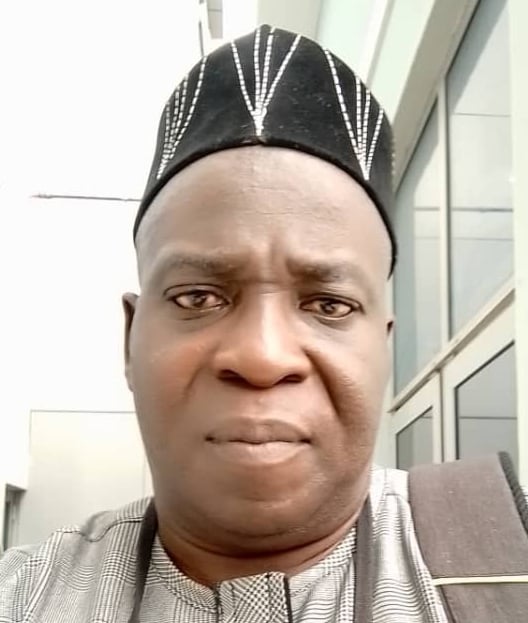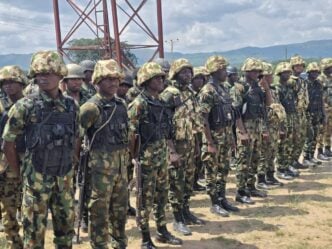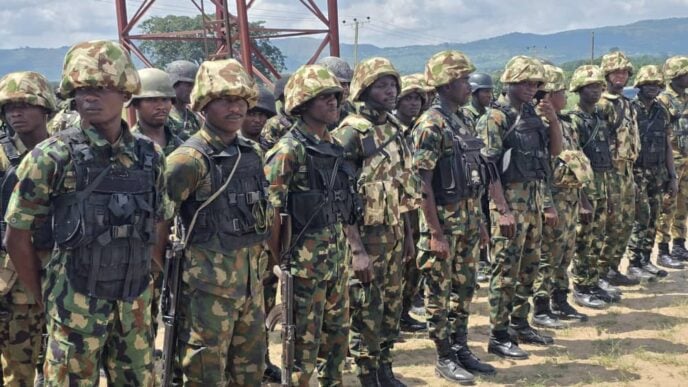American troops (AP Photo/Shakh Aivazov)
While National Security Adviser (NSA) Nuhu Ribadu and his team were holding meetings with rookie Congressman, Riley Moore of West Virginia (he was just elected in January 2025) in Washington D.C the Capital of the United States of America to resolve the issue of alleged genocide on Christians in Nigeria, thousands of miles away in the southwest German city of Stuttgart another series of meetings to plan a military intervention in Nigeria were being held.
The meetings in Stuttgart were taking place in Kelley Barracks in the Mohringen district of the city where AFRICOM (Africa Command) the American Intervention Force in Africa was located.
When President Donald Trump declared that Nigeria a Country of Particular Concern (CPC) over the killings of Christians in the country and proceeded therefrom to indicate that American forces will soon intervene militarily ‘’guns ablazing’’, it was AFRICOM that was tasked with the responsibility of drawing up plans in this regard.
Peter Hegseth, the US Secretary of War cascaded Trump’s orders to the Joint Chief of Staff at the Pentagon (American Defence Headquarters) who in turn forwarded the instructions to AFRICOM headquartered in Stuttgart and commanded by three star Airforce General Dagvin Andersen a veteran of the Iraqi and Afghanistan wars.
Advertisement
For significance, Stuttgart is the sixth largest city in Germany and the global Headquarters of Mercedes-Benz. This city is the capital of the German state (Land) of Baden-Wurttemberg and is where Karl Benz and Gottlieb Daimler first crafted the internal combustion engine making it possible for the building of vehicle engines as we have them today earning the City of Stuttgart as the ‘’Automobile Capital of Germany’’. Stuttgart (Studs garden or farm in German) located by the banks of the Neckar River is the heart of Germany’s ‘’Schwaben Land’’ (Swabians in English) and counts Ferdinand Porsche (the designer of Volkswagen and founder of the Porsche automobile as one of its illustrious sons. Field Marshall Erwin Rommel the famous ‘’Desert Fox’’ though not from Stuttgart is also one of the great sons of the state.
What are General Andersen’s plans for intervention in Nigeria?
General Andersen’s plans for military intervention is structured broadly in three parts. The first part calls for air strikes against Terrorists camps and their convoys, effectively cutting off their infrastructure and networks. The second part calls for stationing of American troops (Boots on ground) in strategic parts of the Nigeria to mop up what is left of the Terrorists and also to go after other insurgent groups. The third part consist of stationing a composite military base made up of units of the US Marine Corp, US Army Infantry, and US Navy. The military base to be stationed somewhere in the Niger Delta will not only keep an eye on Nigeria but also on the Gulf of Guinea which is increasingly becoming a very important strategic sea lane. The plans for air strikes on Terrorists considered three tactical issues; the deployment of Stealth Aircraft; the possible use of carrier-based bombers, ground attack aircraft and missiles; and the use of drones.
Advertisement
The use of stealth bombers was considered against the risks, costs and threats. Is it worth the trouble deploying sophisticated stealth bombers on a country like Nigeria that does not have sophisticated air defense capabilities to detect and deter the likes of B-52 Stealth Bombers over the skies of Nigeria? In the light of this the conclusion was that it will be an overkill to deploy stealth bombers for the Nigerian job.
The next consideration was the use of carrier-based planes or missiles like the tomahawk on Terrorist targets. This was considered too risky as the sight of planes over the Nigerian skies would create unnecessary panic and pandemonium. This could create the rise of sporadic inter-ethnic and inter-religious conflicts right across Nigeria and in the process defeating the overarching aim of the American military intervention in Nigeria. The terrorist could use the panic mode to hide within the population of innocent citizens and even use them as hostages.
Taking these factors into consideration, the option that General Andersen and his AFRICOM team of planners favoured is the use of drones. Drones are considered because they posses the advantages of stealth, less costs in terms of the fact they are unmanned and consume less fuel and less risks in terms of the likely (though remote) factor of accidents. Drones strikes are also favoured due to their relative pin point accuracy on targets. In all compared to Stealth bombers and carrier-based planes, drones can be launched and directed at targets with less risks, less visibility and less costs. Imagine for instance the cost and risk of flying a couple of B-52 bombers to strike at targets in Nigeria. The total cost of running B-52 bombing missions into Nigeria can be achieved with greater number of drones at less risk considering the fact that drones can be safely launched and controlled to the target from anywhere in the world.
The Cognates of a possible American drone strike on targets in Nigeria
Advertisement
Although drone strikes are relatively safer and cheaper in cost than B-52 and carrier-based air strikes, the fact is that drone strikes need a very important cognate in ground based human intelligence (Humint) to infiltrate, identify the location and logistics of the terrorists and their supply chains and routes. Human intelligence would also identify and determine the types of ordnance and platforms used by the terrorists in their operations to enable the level of firepower to be directed at the terrorists. (To be continued)
Gadu can be reached via [email protected] and 08035355706 (Texts only)
Views expressed by contributors are strictly personal and not of TheCable.




